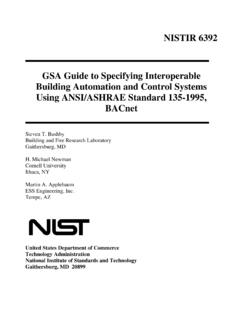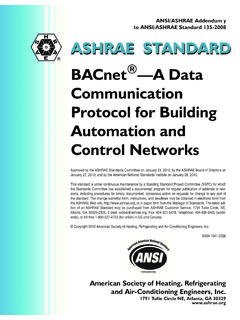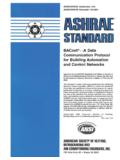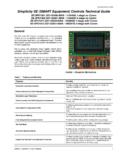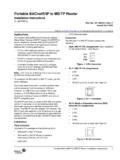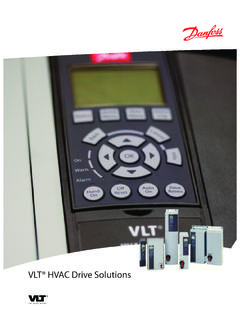Transcription of Fire Alarm Systems with Building Automation and …
1 By Steven T. BushbyINTRODUCTIONI ntegrating fire Alarm Systems with buildingautomation Systems can result in manyeconomic and operational benefits. Suchintegration requires communication standardsand careful design practices. BACnet is aninternationally recognized communicationprotocol standard specifically designed forintegrating Building Automation and controlsystems. Thousands of BACnet Systems canbe found around the world, and its populari-ty is growing. Newly proposed additions toBACnet make it very well suited for integrat-ing fire Alarm Systems with Building automa-tion Protection Engineering5 INTEGRATINGFire Alarm Systems with Building Automation and Control Systems6 Fire Protection EngineeringNUMBER11 Maintaining the integrity of fire alarmsystems when they are integrated withother Building Systems requires morethan just communication design practices, appropriate test-ing procedures.
2 And modernized build-ing are also technology of Building automa-tion and control Systems has advancedrapidly over the past fifteen s technology provides buildingowners and designers with a richassortment of options and personal computer worksta-tions and intelligent distributed con-trollers that process complex algorithmsquickly and efficiently characterizestate-of-the-art Building Automation andcontrol Systems . These advances havetaken place across a variety of buildingservices including heating, ventilating,and air conditioning (HVAC) controlsystems, lighting control Systems , accesscontrol Systems , and fire Alarm spite of these advances, buildingowners have been frustrated by theinability to bid projects competitivelyand to integrate innovative productsmade by different manufacturers in waysthat best suit the unique needs of theirfacility.
3 The main obstacle has beenincompatible proprietary communicationprotocols. The adoption of BACnet1asthe standard communication protocol forintegrating Building control products haschanged the industry and opened thedoor to new innovation in Building con-trol technology and true integration ofpreviously isolated Building the United States, the NationalElectrical Manufacturer s Association(NEMA) Signaling, Protection, andCommunication Section (3SB) hasendorsed the use of BACnet as the pre-ferred way to integrate fire Alarm sys-tems with other Building control sys-tems. The National Fire ProtectionAssociation (NFPA) is in the process ofrevising NFPA 722to address designissues related to integrating fire alarmsystems with other Building BACnet fire Alarm sys-tem products are already available inthe marketplace in the United Statesand in Europe.
4 These are clear indica-tions of interest in integrating fire alarmsystems with other Building systemsand in using the BACnet protocol as ameans to accomplish that BACNET OVERVIEWBACnet is a standard communicationprotocol developed by the AmericanSociety of Heating Refrigerating, andAir-Conditioning Engineers (ASHRAE).It has been adopted as a prestandardby the European Community3,4and hasbeen proposed as an ISO there are over 70 companieswith registered BACnet vendor identi-fiers. These companies are located inNorth America, Europe, Asia, andAustralia. Commercial BACnet productofferings range from gateways thatconnect proprietary Systems to com-plete product lines that use BACnet asthe primary or sole means of commu-nication.
5 There are thousands ofinstalled Systems ranging in complexityfrom a single gateway to very largeoffice buildings with top-to-bottomnative BACnet Systems , to campus orcity- wide Systems linking multiplebuildings. BACnet products includeHVAC controls, lighting controls,access controls, and fire detection , BACnet, like anycommunication protocol, is a set ofrules that provide a way to exchangeinformation. BACnet was designed andoptimized specifically to meet theneeds of Building Automation and con-trol applications, and to convey thedata needed by these applicationsincluding, but not limited to, hardwarebinary input and output values; hard-ware analog input and output values;software binary and analog values;schedule information; Alarm and eventinformation; files; and control does not define the internalconfiguration, data structures, or controllogic of the controllers.
6 BACnet is designed to be scalablefrom very small, low-cost devices tovery large complex Systems that mayinvolve thousands of devices and multi-ple buildings located anywhere in theworld. It achieves this by combining anobject-oriented representation of theinformation to be exchanged, flexiblechoices for local area network (LAN)technology, an ability to interconnectlocal area networks, and an ability touse Internet protocols (IP) to link build-Figure 1. BACnet Protocol ArchitectureBACnet Application LayerBACnet Network LayerBACnet LayersEquilaventOSI LayersApplicationNetworkData LinkPhysicalISO 8802-2 (IEEE )Type 1 ISO 8802-3(IEEE )ARCNETMS/TPEIA - 485 PTPEIA - 232 LonTalkSUMMER2001 Fire Protection Engineering7ings over wide area networks.
7 Thestructure of the BACnet protocol and itsrelationship to the Open SystemsInterconnection (OSI) Basic ReferenceModel5is shown in Figure represents the informationand functionality of any device bydefining collections of related informa-tion called objects, each of which hasa set of properties that further charac-terize it. For example, an analog inputis represented by a BACnet AnalogInput object that has a set of propertiesthat include its present value, sensortype, location, Alarm limits, and properties are required and oth-ers are optional. A device is represent-ed by an appropriate collection of net-work-visible objects. Once the informa-tion and functionality of a device arerepresented on the network in terms ofstandard objects and properties, mes-sages can be defined to access andmanipulate this information in a stan-dard way.
8 This combination of standardobjects and standard messages toaccess and manipulate their propertiesmakes up the BACnet application the information to beexchanged and message structures aredefined, it is necessary to provide away to transfer the information fromone place to another. BACnet providesa choice of five LAN technologies tomeet this need. Several choices are pro-vided because different Building controlapplications must meet different costand performance constraints. A singlenetwork technology cannot meet theneeds of all applications. A LAN isdefined by a combination of the datalink and physical layers of the OSImodel. The LAN options available inBACnet are shown in Figure first option is ISO 8802-3, betterknown as Ethernet.
9 It is the fastestoption and is typically used to connectworkstations and high-end fielddevices. The second option is ARCNET,which comes in modestly high speedsor in slower, lower-cost defines the MS/TP (master-slave/token-passing) network designedto run over twisted-pair s proprietary LonTalk* networkcan also be used. The Ethernet, ARC-NET, and LonTalk options all support avariety of physical media. BACnet alsodefines a dial-up or point-to-point protocol called PTP for use over phonelines or hardwired EIA-232 connections. A key point is that BACnet messagesare the same no matter which LAN isused. This makes it possible to easilycombine LAN technologies into a singlesystem.
10 The purpose of the networklayer is to provide a way to make suchinterconnections. It is common in largesystems to combine high-speed (andhigh-cost) networks with lower-speed(and lower-cost) networks in a singlesystem. Such a system is shown inFigure 2. Figure 2 also illustrates thatBACnet has wide area networkingcapability that is implemented using principle, BACnet messages canbe transported by any network technol-ogy. This means that technologies thathave not even been invented yet canbe used in the future to convey BACnetmessages, and they can be integratedinto today s Systems in the same waythat multiple existing network technolo-gies can be combined today.


